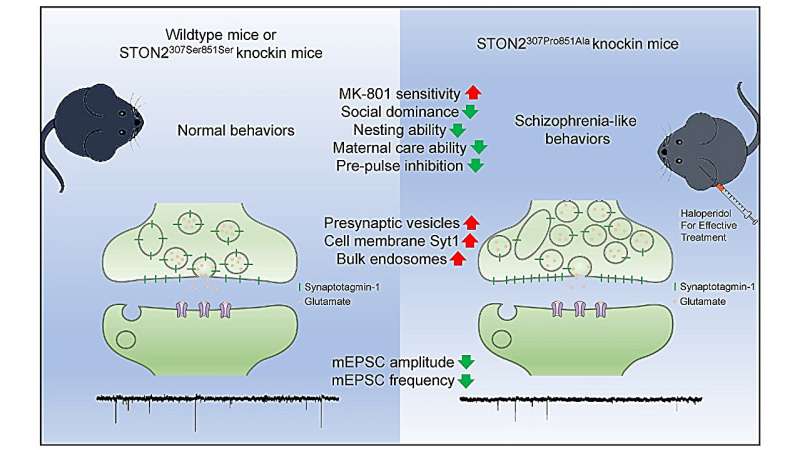STON2307Pro851Ala knockin mice exhibited deficits in synaptic function and schizophrenia-like behaviors, which could be restored by haloperidol administration. Credit: Science China Press
Schizophrenia is a severe mental disorder characterized by positive symptoms, negative symptoms, and cognitive deficits, with heritability estimates of approximately 80%. Synaptic dysfunction is a core component of the pathophysiology of schizophrenia. However, the genetic risk factors and molecular mechanisms related to synaptic dysfunction are still not fully understood.
Clathrin-mediated endocytosis (CME) plays a crucial role in synaptic vesicle trafficking, and it has been hypothesized that CME impairment contributes to neuropathology related to schizophrenia. A study published in the journal Science Bulletin found that the C-C (307Pro-851Ala) haplotype of STON2 increases susceptibility to schizophrenia in the Chinese Han population, and these variations cause schizophrenia-like behaviors in mice through the regulation of CME.
The researchers revealed that schizophrenia-related STON2 variations led to protein dephosphorylation, which affected the interaction of the protein with synaptotagmin 1 (Syt1), a calcium sensor protein located in the presynaptic membrane that is critical for CME. STON2307Pro851Ala knockin mice exhibited deficits in synaptic transmission, short-term plasticity, and schizophrenia-like behaviors.
Moreover, Pharmacogenomic data revealed that patients with the C-C (307Pro-851Ala) haplotype responded better to haloperidol, and haloperidol administration restored the schizophrenia-related behaviors of STON2307Pro851Ala knock in mice through the regulation of Syt1 sorting and synaptic transmission.
The findings demonstrated the effect of schizophrenia-related STON2 variations on CME and synaptic function, which might be attractive therapeutic targets for treating schizophrenia-like phenotypes.
This study was led by Prof. Jun Li (Peking University Sixth Hospital), Prof. Dai Zhang (Peking University Sixth Hospital), Dr. Yuanlin Ma (Peking University Sixth Hospital; The First Affiliated Hospital of Chongqing Medical University), and Dr. Kai Gao (Peking University Sixth hospital; Changping Laboratory).
More information: Yuanlin Ma et al, STON2 variations are involved in synaptic dysfunction and schizophrenia-like behaviors by regulating Syt1 trafficking, Science Bulletin (2024). DOI: 10.1016/j.scib.2024.02.013
Provided by Science China Press
























